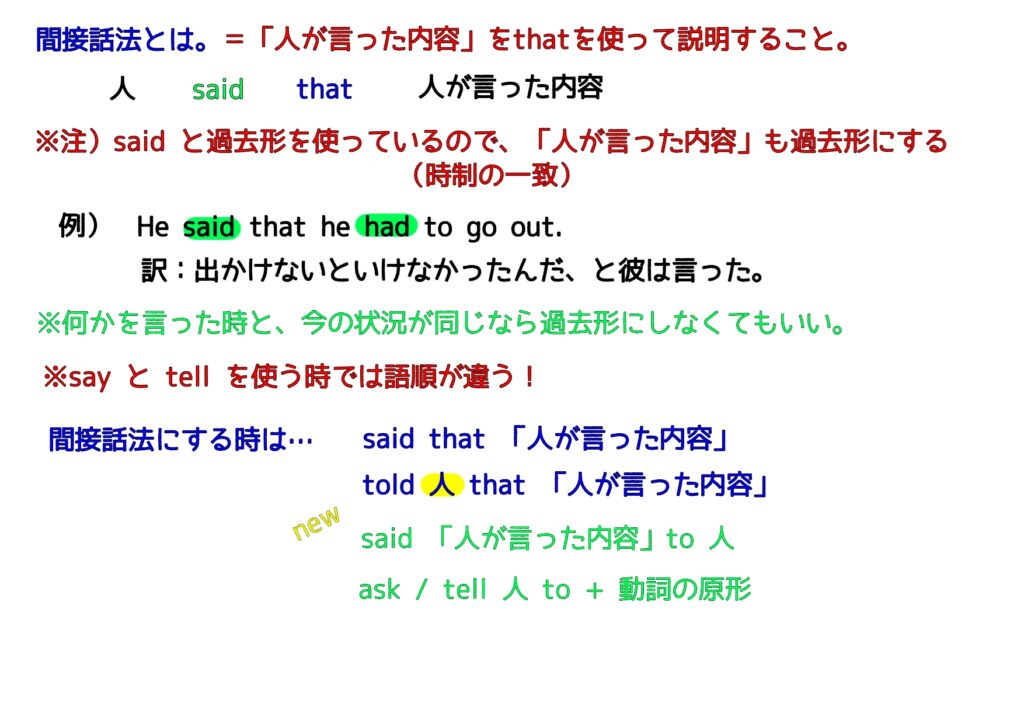第36回:間接話法だけれども、that 節を使わないものがあります。

どのような単語を使う時に、that 節を使わないのかを見てみましょう。
Q. この記事で、一番大事なことって何?
A. 大事なことを、1枚の画像にまとめました。

いちいちノートにまとめるのが面倒だという方、また、
ノートにまとめることが苦手だという方は、ご活用ください。

[広告]
確かな英語力は、日々の継続から。
その継続を後押しする、第二言語習得理論に基づいた
オンライン英語学習プログラムがあります。
英語を使う人のための、確実なスキルアップが望める
7日間の無料体験はこちらから!

間接話法を極める
①:ある報告する動詞の後ろには、「to + 動詞の原形 (不定詞節)」をつけることができます。例えば、「propose」や「agree」、「demand」、「guarantee」、「offer」、「promise」、「swear」、「threaten」、「volunteer」などが挙げられます。例えば、「They propose to build the theater next to the town hall」といった表現があります。
②:「advice」や「ask」、「call on」、「command」、「instruct」、「invite」、「order」、「persuade」、「recommend」、「remind」、「request」、「urge」、「warn」、「tell」などの動詞を使う場合には、「目的語 + to + 動詞の原形 (不定詞節)」を使うことができます。「目的語」は、提案やオファーを受ける側の人物を指します。例えば、「She encouraged Fran to take the job」といった表現があります。
③:「that-clause」を後に続ける動詞もあります。例えば、「promise」や「agree」、「demand」、「expect」、「guarantee」、「hope」、「propose」、「request」、「vow」などが挙げられます。これらの単語は「to + 動詞の原形 (不定詞節)」ではなく、「that 節」を使います。また、「that 節」を使う場合、約束や提案をする人物と、報告された内容を受ける人物が異なる場合があります。
④:「insist」、「order」、「say」、「suggest」を使う場合には、「that 節」を使います。例えば、「There were cheers when he suggested that we went home early」といった表現があります。「advise」と「order」に関しては、「目的語 + to + 動詞の原形(不定詞節)」または「that 節」のどちらでも使うことができます。「that 節」を使う場合は、「should」を含める必要があります。
⑤:「long」や「offer」、「refuse」、「volunteer」、「want」などの動詞に関しては、「to + 動詞の原形(不定詞節)」を使います。例えば、「Carolyn intends to return to Dublin after a year in Canada」といった表現があります。また、「recommend」や「advise」、「propose」、「suggest」を使う場合には、「that 節」の代わりに、「動詞-ing(現在分詞節)」を使うこともできます。例えば、「The lecturer recommended reading a number of books before the exam」といった表現があります。
具体例
- Verb + (object) + to-infinitive clause:
- Offer: “I’ll help you with your homework,” said John. -> John offered to help with the homework.
- Promise: “I’ll call you tomorrow,” said Sarah. -> Sarah promised to call tomorrow.
- Recommend: “You should try the new restaurant,” said Jane. -> Jane recommended trying the new restaurant.
- Verb + that-clause or verb+ to-infinitive clause:
- Request: “Can you give me a ride to the airport?” said Tom. -> Tom requested that someone give him a ride to the airport (or Tom requested to be given a ride to the airport).
- Expect: “I think they’ll arrive at 7 pm,” said Mary. -> Mary expected that they would arrive at 7 pm.
- Propose: “Let’s go to the beach tomorrow,” said Alex. -> Alex proposed that they go to the beach tomorrow.
- After the verbs insist, order, say and suggest we use a that-clause but not a to-infinitive clause:
- Insist: “I want you to come with me,” said David. -> David insisted that the other person come with him (not David insisted to come with him).
- Order: “Close the window,” said the teacher. -> The teacher ordered that the window be closed (not The teacher ordered to close the window).
- Suggest: “Why don’t we watch a movie tonight?” said Susan. -> Susan suggested that they watch a movie tonight (not Susan suggested to watch a movie tonight).
- Verb + to-infinitive clause (not verb + that-clause):
- Want: “I want to buy a new car,” said Mike. -> Mike wants to buy a new car (not Mike wants that he should buy a new car).
- Refuse: “I won’t go to the party,” said Sarah. -> Sarah refused to go to the party (not Sarah refused that she should go to the party).
- Offer: “I’ll help you move to your new house,” said Tom. -> Tom offered to help move to the new house (not Tom offered that he should help move to the new house).
- When we report a suggestion, either what the person reported might do themselves or what someone else might do, we can use a reporting clause with advise, propose, recommend or suggest followed by an -ing clause rather than a that-clause:
- Suggest: “Why don’t you try going to the gym?” said Jack. -> Jack suggested trying going to the gym (or Jack suggested that you should try going to the gym).
- Recommend: “You should visit the art museum,” said Emily. -> Emily recommended visiting the art museum (or Emily recommended that you should visit the art museum).
[広告]
TOEICのスコアを上げたいけれど、
まとまった勉強時間が取れなくて困っている…
なら、細かいスキマの時間を使いながら、
少しずつスキルを積み重ねてみてはどうでしょう。
スマホ1つでスコアアップが出来る、
オンライン講座のリンクはこちらから。

Q. この文法はどうやって使うのでしょうか?
A. 今回の文法を活用した会話文を見てみましょう。

Have you heard about the new theater they’re building?
(新しい映画館のこと聞いた?)

No, I haven’t. What’s the plan?
(いや、聞いてないよ。どんな計画?)

They propose to build it next to the town hall.
(市役所の隣に建てるつもりだって言ってるんだ。)

That sounds like a good location. Did they give any details about it?
(いいロケーションだね。詳細は何か言ってた?)

Not really, but I heard they guarantee it’ll be a great addition to the city.
(あんまりないんだけど、街の良い施設になることを確信してるって聞いたよ。)

That’s exciting. Maybe we should volunteer to help with the construction.
(それはわくわくするね。建設の手伝いに行こうかな。)

That’s a great idea! I’ll suggest it to the project manager.
(いいね!プロジェクトマネージャーに提案してみるよ。)
[広告]
ロゼッタストーン・ラーニングセンターで、最先端の教育制度を活用して英語を学びませんか?私たちは個々の学習ペースに合わせてeラーニングと対面教育を組み合わせ、柔軟な学習環境を提供しています。自宅でのeラーニングと対面教育のメリットを最大限に活かし、あなたの英語学習をサポートします。最新のテクノロジーと個別の指導が組み合わさった当センターで、自由な学習スタイルを体験してみませんか?英語学習を楽しく効果的に進めるための環境がここにあります。新たな一歩を踏み出して、新しい英語学習の旅に参加しましょう!

Q. この記事の要点は?
A. 間接話法を使う際の、表現の幅を確認しました。
- 提案や注文、意図、約束、依頼などを報告する際、報告文に続く動詞のいくつかはto不定詞節に続けることができます。例えば、agree、demand、guarantee、offer、promise、swear、threaten、volunteerなどがあります。
- 目的語は通常、提案や注文などの対象となる人を指します。advice、ask、call on、command、instruct、invite、order、persuade、recommend、remind、request、urge、warn、tellなどの動詞が使えます。
- いくつかの動詞に対しては、to不定詞節の代わりにthat節を使うこともできます。agree、demand、expect、guarantee、hope、propose、request、vowなどが挙げられます。
- Insist、order、say、suggestのような動詞は、that節だけを使うことができ、to不定詞節は使えません。
- long、offer、refuse、volunteer、wantのような動詞は、to不定詞節だけを使います。
- 提案を報告する際には、advise、propose、recommend、suggestに続けて、that節の代わりに-ing形式の節を使うこともできます。
英会話を始めてみたいけれど、どのサービスが良いか分からない…
そんな方は、まず、この記事で3つのサービスを比べてみてはいかがでしょうか?
英語力を効率良く伸ばすことができるサービス3選です。

次回の文法解説は?
この記事を作る際に参考にした文法の解説書になります。
すべて英語で書かれていますが、練習問題が付いてます。
イギリス英語なので、スペル等の表記が異なる部分もありますが、
「使い方を練習したい」「繰り返し問題を解きたい」
という方は、使ってみても良いかもしれません。

関連記事一覧
[広告]
日本人の講師と学んで、英語を使う不安を減らし、
ネイティブの講師とのレッスンで、学んだことを活用する
そんな、体系的な英会話のレッスンを提供している、
オンライン英会話スクールのリンクはこちら。

他の文法解説記事を検索できます。





-320x180.jpg)
-320x180.jpg)
-320x180.jpg)

-320x180.jpg)
-320x180.jpg)





コメント